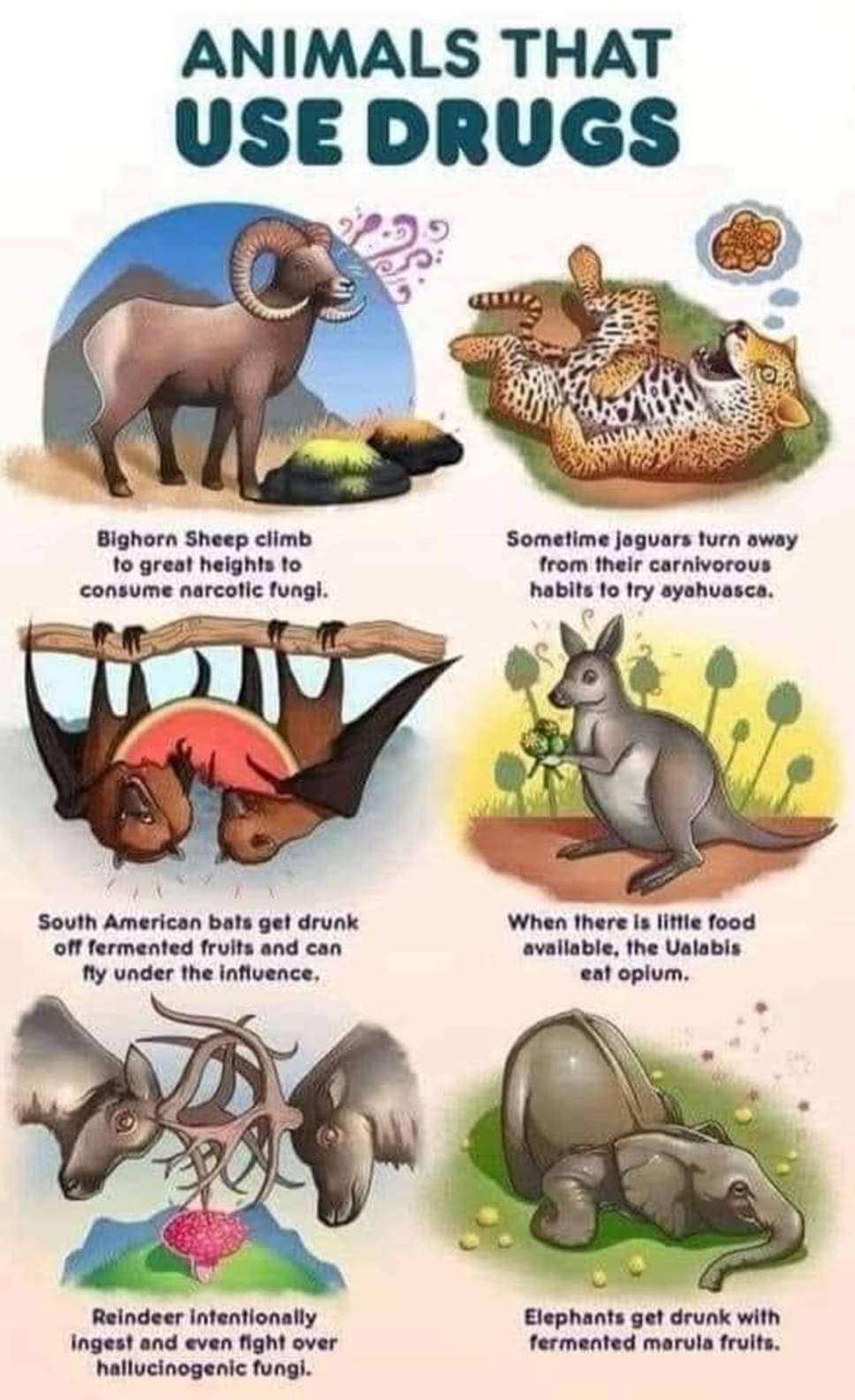Leemurs provoke centipedes to make them excrete their defensive toxin, but then the lemurs just use that toxin to get high and repel mosquitos.
Science Memes
Welcome to c/science_memes @ Mander.xyz!
A place for majestic STEMLORD peacocking, as well as memes about the realities of working in a lab.

Rules
- Don't throw mud. Behave like an intellectual and remember the human.
- Keep it rooted (on topic).
- No spam.
- Infographics welcome, get schooled.
This is a science community. We use the Dawkins definition of meme.
Research Committee
Other Mander Communities
Science and Research
Biology and Life Sciences
- [email protected]
- [email protected]
- [email protected]
- [email protected]
- [email protected]
- [email protected]
- [email protected]
- [email protected]
- [email protected]
- [email protected]
- [email protected]
- [email protected]
- [email protected]
- [email protected]
- [email protected]
- [email protected]
- [email protected]
- [email protected]
- [email protected]
- [email protected]
- [email protected]
- [email protected]
- [email protected]
- [email protected]
- !reptiles and [email protected]
Physical Sciences
- [email protected]
- [email protected]
- [email protected]
- [email protected]
- [email protected]
- [email protected]
- [email protected]
- [email protected]
- [email protected]
Humanities and Social Sciences
Practical and Applied Sciences
- !exercise-and [email protected]
- [email protected]
- !self [email protected]
- [email protected]
- [email protected]
- [email protected]
Memes
Miscellaneous
The word just is doing a lot of heavy lifting there.
Get high and repel mosquitos?
Sign me up!
Bees also get drunk. If they try to enter the hive while drunk, they get kicked out to sober up
From what I read they don't only get kicked out but absolutely mutilated by ripping their limbs off
the fuck is a ualabi.
(Bad example if they mean wallaby, opium is an invasive species and they only eat it out of desperation. A better one would be the chronically addled eucalyptic meth head that is the koala)
And dolphins like to kick puffer fish around to get high

This is only a reenactment
The ulabis doesn't really seem to fit the infographic.
Eating opium plants when food is scarce doesn't really fall under the "drug use" category as it seems like it would have to be done.
The other uses were chosen
opium plants
Do you mean "poppies?"
Does it matter, mr. Pedantic?
Naw. Enjoy your hamburger meat animal sandwiches.
Accuracy and pedantry are different.
Enjoy your hamburger meat animal sandwiches.
With bread buns?
Yes, made with pulverized grain wheat flour dust
Aye, poppy
What? No way bats can fly under influence! They are not above the law.
I am not sure if I am scared of a high jaguar or want to pet it. Maybe both?
Jaguar to his buddy: "Dude, I was so baked I let a hairless monkey pet me. I got the munchies though, so I ate him."
This is documentary video of animals on the savannah eating fermented marula is great
the hung over warthog is so relateable!
I was going to recommend the movie this is from, "Animals are Beautiful People"! It's an older Disney produced documentary from the 70s I think. They put a comedic twist on the narraration and add plenty of cartoon sound affects throughout the film
I do not recommend it. Firstly, it's not a Disney movie. It was made by a white South African in South Africa during apartheid.
A lot of it is just made up and some of it is clearly animal abuse. There's no question that a weaver bird nest was set on fire for the movie.
The elephant thing isn't even true. It's staged with creative editing.
https://www.krugerpark.co.za/krugerpark-times-3-8-elephant-myth-22760.html
I remember reading that the Sami people used to drink the piss of a reindeer that had eaten fly agaric/fly amanita mushrooms since even though they're poisonous, most of the poison gets left in the reindeer while the nice hallucinogenic stuff passes through. Wikipedia put it a bit differently:
Patrick Harding describes the Sami custom of processing the fly agaric through reindeer.
Processing does sound nicer.
How can jaguars consume ayahuasca if it is a beverage containing various ingredients that work together to be potent? What do they actually consume?
Ayahuasca is a hallucinogen commonly made by the prolonged decoction of the stems of the Banisteriopsis caapi vine and the leaves of the Psychotria viridis shrub, although hundreds of species are used in addition or substitution (See "Preparation" below). P. viridis contains N,N-Dimethyltryptamine (DMT), a highly psychedelic substance. Although orally inactive, B. caapi is rich with harmala alkaloids, such as harmine, harmaline and tetrahydroharmine (THH), which can act as monoamine oxidase inhibitors (MAOi). This halts the liver and gastrointestinal metabolism of DMT, allowing it to reach the systemic circulation and the brain, where it activates 5-HT1A/2A/2C receptors in frontal and paralimbic areas.
Do they consume Psychotria viridis leaves and does the DMT work this way?
Just a guess, but carnivores usually have extra potent stomach acids. Maybe there is a different chemical reaction that activates the 'DMT' effect in a different but similar way?
Apparently the jaguars don't eat the DMT containing shrub P. viridis, but this other ingredient in ayahuasca called yage (Banisteriopsis caapi) that does not contain DMT (see the other response to my last comment).
Harmine, 0.31–8.43% Harmaline, 0.03–0.83% Tetrahydroharmine, 0.05–2.94% These alkaloids of the beta-carboline class act as monoamine oxidase inhibitor (MAOIs).
So, no psychoactive substance, right??
Maybe the jaguars are not actually tripping but are just using it for their metabolism?
MAOIs are also used as antidepressants in humans because they inhibit the metabolism of monoamine compounds such as serotonin and norepinephrine.. Maybe the jaguars are going for this?
Thanks. That was a bit too anecdotal for me so I actually searched around a bit more. Didn't find much but at least this one review article:
https://www.thieme-connect.com/products/ejournals/pdf/10.1055/a-1586-1665.pdf
Banisteriopsis caapi (Spruce ex Griseb.) C. V. Morton (Malpighiaceae): jaguar Some Amazonian people credit their uses of Banisteriopsis caapi, also widely known as ‘ayahuasca,’ from watching jaguars [14]. In the Amazonian rainforest, jaguars have been filmed gnawing on the bitter roots, bark and leaves of this plant, after which they appear dazed, rolling on their backs (www.youtube.com/watch?v=OqGDv0KCJl8). A similar behavior reported in many felid species, including domestic cats, is the frenzy induced by catnip (Nepeta cataria L.) or silver vine (Actinidia polygama [Siebold & Zucc.] Planch. ex Maxim.), which are reported to also have mosquito-and bedbug-repellent activities [54, 55].
[...]
Jaguarsʼ ingestion of ayahuasca can tentatively be classified as Mode 3 self-medication, for many of the same reasons given above, or possibly Mode 4 if evidence were available to show jaguars using the plant were doing so directly for its anthelmintic properties. However, more detailed information is needed to further understand the context of jaguars and other animals consuming plants with hallucinogenic properties by; for example, do they hunt afterwards, or do they ingest plants when parasite levels are high, and does it subsequently lower these levels? The plantʼs properties could promote alertness or simply be a byproduct of Jaguarsʼ hedonic attraction to the plant, with the functional value being its antiparasitic properties. These pharmacological properties lend support to the functional aspects of the plant for jaguars, but more work needs to be done to understand the possible adaptive value of hallucinogen ingestion in animals.
Although the presented evidence is again this same short, very heavily edited video of a jaguar supposedly tripping on the yage vine.
And regarding the effect on or the reasons of the jaguar, we apparently don't know and how could we, if all the evidence is this one short clip already suggesting what it is doing? Not very satisfying I must say.
ETA: OK, so I dug a bit deeper as seen in my other comment. Apparently this vine isn't even really psychoactive: "The harmala alkaloids are not especially psychedelic, even at higher dosages, when hypnagogic visions, alongside vomiting and diarrhea, become the main effect." So, what are the jaguars tripping on then? Maybe they aren't! Maybe they use it for its purgative effects? This seems all extremely sketchy to me. I don't think we can definitely say that jaguars are using these vines for their psychoactive effects and saying that they are tripping on ayahuasca is definitely wrong.
Jaguars actually eat the leaves of b. capii, which acts as a MAOI in the Ayahuasca brew.
While there is some discussion that the harmala alkaloids in b. capii might also be slightly psychoactive in high doses, the actual main compound in Ayahuasca is DMT, which is certainly very psychoactive, but not bioavailable when consumed orally without a MAOI. Unless the jaguars have figured out how to combine the two and/or brew ayahuasca, I strongly doubt that's their intention and that they'd get comparable effects.
I think the idea stems from the BBC show Weird Nature showing a jaguar eating yage leaves in episode 6, "Peculiar Potions".
I'm not really sold on how well that content was researched.
Came here for this, I was looking forward to having a Jaguar shaman for my aya ceremony but I guess that's off now
B. caapi is called ayahuasca, as well as being an ingredient in the brew with the same name, so the image is not technically wrong.
Sure. In my opinion, however, the overall context of the image does imply the jaguar enjoys similar effects to those clearly requiring the presence of DMT, as that is what is most people commonly associate with ayahuasca.
It's a bit of a "look at all those animals getting high, this jaguar is even talking to machine elves in the 19th dimension" kinda thing, where - if I remember correctly - they actually consume the leaves for digestive purposes.
Again, the leaves do have an effect, e. g. they apparently act as an SSRI (that's how common antidepressants work) and we can't be absolutely sure about their effect on cats (catnip certainly has some effect on cats we don't readily enjoy), so I can't dismiss the notion of jaguars seeking them out for that reason as well.
"Ualabis"? Is that supposed to be "wallabies"?
As best I can tell from searching, that's kind of the Spanish word for "wallabies" (translate gives "ualabies"). Seems like a weird choice.
What about the birds that get drunk off of fermented cherries and smash into a stuff? We need to do something about these FWIs or nobody will be safe.
honestly basically any animal that eats fruit will end up drunk at some point, a classic children's story here in sweden has a scene where their chickens get drunk, and it's pretty regular fare to hear about moose getting drunk on fermented apples from peoples' back yards.
